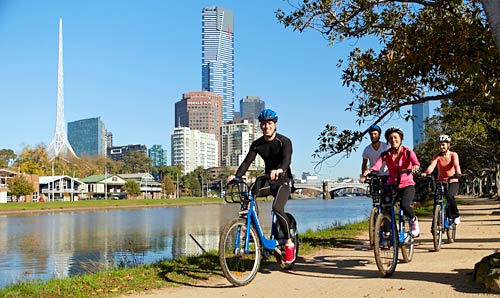
Melbourne’s air quality has improved since the 1980s. Compared with similar cities in other countries, our air quality is relatively good. Particle pollution is currently the major issue needing attention, although other pollutants such as ozone are also of concern. Air quality is consistently ranked by the community as an important environmental issue.
Measuring improvement in air quality
When EPA began air monitoring in Melbourne and Geelong in 1973, air pollution was getting worse. We saw significant improvements in the following two decades, largely due to the introduction of emission controls on cars and industry complying with EPA standards. Since the nineties, improvements have been less dramatic, but carbon monoxide (CO) and nitrogen dioxide (NO2) have continued to decrease. The removal of lead from petrol has caused a dramatic drop in lead levels.
In general, pollution levels vary from year to year because of changes in the weather.
Air pollution events
Melbourne suffers from four major forms of air pollution.
- Summer smog: This occurs or warm sunny days from November to March, when light winds recirculate around the city. On such days, sunlight can cause chemical reactions between pollutants, leading to ozone which is harmful to human health.
- Winter smog: This occurs on cold days with light winds, typically from April to August, when pollutants build up and stay around the city, sometimes for several days. Particles are the main pollutant of concern during winter smog events. Urban smog particles can affect our health and reduce visibility.
- Wind-blown dust: During strong winds dust can be transported long distances — for example, from the Mallee or Wimmera all the way to Melbourne. Dust can also be a significant local problem - it can be lifted by the wind from unsealed roads, construction sites, or bare soil. Dust can also be lifted into the air by earthworks or moving vehicles, and then blown by the wind.
- Smoke: Smoke from bushfires and planned burns can lead to significant deterioration in air quality in summer and autumn. Smoke from fires can cause very high concentrations of fine particles and can significantly reduce visibility.
How to help reduce air pollution every day
Most of us probably cause air pollution in one way or another, but the good news is that we can do something to reduce emissions every day. Some actions take more commitment than others, but there's a way for each of us to play our part:
- Keep your car regularly tuned and maintained to cut car pollution by up to 25 per cent. You’ll also save on fuel.
- Drive smoothly and plan your trips – you’ll arrive just as quickly and save more on fuel.
- Keep your car’s tyres inflated to the manufacturer’s specifications.
- Try riding a bike or walking instead of using a car. Use public transport wherever you can.
- When you trade in your old car consider a fuel-efficient, low emission car as a replacement.
- Limit your use of wood fireplaces to special occasions.
- Report smoky vehicles.
Links